Left foot braking
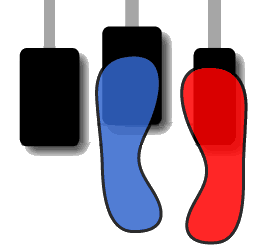
Left-foot braking is primarily used in front-wheel-drive cars and comes in handy during cornering at high speeds.
Story is that left foot braking was invented by rally drivers, and I believe in that story.
Left foot braking is a technique used mostly and frequently in rallying, but can be equally useful on the road or track for:
- Non gear change corners:
Left foot brake in all the way to the apex (trail braking) and your right foot can immediately get back on the throttle. This cut the delay in getting on the power. - Slower corners:
Big gains in late are available as with your left foot already over the brake, you can go from power to braking immediately. - Medium speed corners:
With most road cars the improved handling response with a little drag on the brakes makes corner entry faster and more accurate. Pressing lightly on the brake with or without the power on, improves the poise of the car because of weight transfer to front. - Fast corners:
With softly sprung road cars in fast bends, going from braking to accelerating upsets the car. You can balance the car by using both the throttle and brake together. On the way in apply the brakes and keep the throttle down, release the throttle more and apply more brakes to slow and balance the car, never lift of the throttle completely, then accelerate at the apex keeping some brake on only releasing them completely when the car is balanced again. - Ultra fast corners:
A dab on the brakes keeps the engine pulling and is better than a lift off the throttle (particularly if you're running curbs). - Gear change corners:
Left foot brake in all the way to the apex and blip right foot to change gear (only works in higher gears, 3rd to 2nd is trickier) and get back on the throttle. - Unknown corners, corrections and emergencies:
When in rally mode charging around unfamiliar corners a left poised over the brake can either allow for a dab on the brakes to improve turn in, shed speed or come to a big stop when things have gone badly wrong.
There's no doubt that left foot braking is better in emergencies if the foot is already covering the brakes, a heavy tug on the gear lever puts you into neutral while the left foot is already braking - Up someone's rear:
Keep the left foot covering the brake, in case of emergencies. When preparing to overtake press the throttle and balance the speed on the brake, when going to pull out release the brake and press the throttle all the way down - Someone's up your rear:
Dab your left foot on the brake just enough to light up the brake lights, great fun, especially under heavy acceleration really confuses them. - Removing the pedal transfer time between accelerator and brake:
Using the left foot to brake removes the pedal transition time from brake to accelerator and vice versa. This can shave fractions of a second off a lap time when done well, but cannot be used when it is necessary to change down a gear (unless you decide not to use the clutch!)
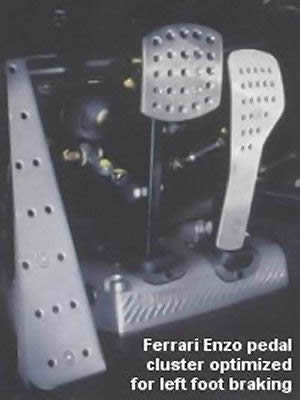 |
 |
When driven under acceleration with no brakes applied, a front wheel drive car will understeer when the front wheels are turned. To overcome this problem, a technique called left foot braking is used to change brake bias (brake balance) to the rear. By using a combination of throttle and brake you can change from understeer to neutral steer to oversteer.
Rally drivers can use a means of biasing the brakes to the rear. Some of the things that can be done are using a brake bias control valve or installing more powerful brakes on the rear wheels. That works wonderful on a track, but on a rally it's hard to change your brake bias in the middle of a turn that suddenly changes from dry dirt with good grip, to wet slime with no grip. That's why they use left foot braking.
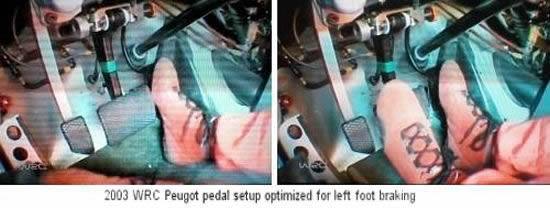
Most initial attempts at left foot braking scare most drivers into never trying it again. Left foot braking is an advanced technique, and should only be attempted after lots of practice. When learning to left foot brake, you'll initially press the pedal far too hard as you'll be used to the action of pressing a clutch all the way to the floor. It takes time to re-programme the muscle memory of your left foot and leg, and a bit of empty tarmac is recommended.
To make use of the left foot braking you need also to control the throttle at the same time. On a faster empty straight road try to gently left foot brake and blip the throttle repeatedly to get the feel and to feel the effect. From here the world of left foot braking is literally at your feet.
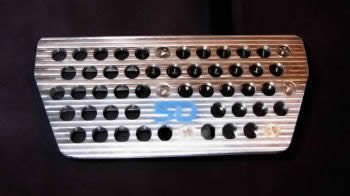 Aftermarket pedal optimized for left foot braking
Aftermarket pedal optimized for left foot braking
How does it work?
Think about this for a second. When you stand on the throttle, which way does your body try to go? Toward the rear wheels! Right? Now what happens when you brake? Your body tried to go forward! This is weight transfer! By using the basic rules of weight transfer and a combination of throttle and left foot braking, you can be in control when the unexpected happens.
Brake bias in normal street cars is toward the front wheels for safety reasons. If you have ever pulled up your hand brake when turning on a wet road and spun out, you know why they build cars this way. What you did was bias the brakes to the rear, and this is not what you wants coming home from the supermarket.
So, what can you do? A severe problem affecting most front-drivers is understeer during fast cornering. Understeer generally means that during cornering at a high speed, the car has a tendency to keep moving straight and to the outer edge of the curving road rather than the direction in which you are pointing the wheels. To cancel out understeer, there should be more grip at the front wheels than at the rear. The left-foot braking technique more or less helps you to do just that. Applying a bit of brake during acceleration, the car's weight is transferred to the front, causing the front wheels to have more grip than the rear tires. The car now starts to oversteer. Basically you are changing brake bias. You can change the brake bias by either adding power or brake pressure (this is also called "modulating").
Nice example of left foot braking and heel and toe technique.
By applying brake with the throttle at same time in a front wheel drive car, two things happen. One: The front wheels keep turning. And two: The rear wheels try to lock up. If you are in a turn, the back of the car will start to slide toward the outside of the turn. To control or stop the slide, apply less brake and more power. This will change oversteer toward understeer and stops the rear wheels from sliding toward the outside of the turn.
Example: You are in a turn and the rear of the car starts to slide out more then you want. You could release some brake pressure and increase the throttle. This will change oversteer to understeer. The reverse is also true. If the turn tightened, you can change to oversteer by increasing brake pressure against the throttle. Also by balancing the brake and throttle you can get a neutral steer.
Now you have to keep the car in control by steering in the direction that you want to go, and applying more or less throttle and braking as needed. You have to use both your pedals at the same time, which will take practice. Lifting off the accelerator will cause more oversteer and flip out the car's rear even more. Applying more throttle while easing off the brakes will reduce oversteer and straighten out the car. Keep performing this balancing act to smoothly clear the corner at high speed, all the while making little corrections to your steering. At the end of the corner, just lift your foot from brake, floor it and power out.
When you get good at this technique, you should be able to just keep the accelerator completely floored and keep the car moving in your preferred direction using just your brake pedal and steering wheel. Understeer is eliminated if done correctly and you clear the corner at a higher speed than in normal driving. The trick is to keep practicing braking with the left foot and learn to apply the brakes as well with the left foot as with the right.
With a typical race-car gearbox, you can even start braking with your left foot instead of your right without having to use the clutch pedal. When braking, you can blip the throttle (so called Rev-matching) between the gear changes. Most normal gearboxes cannot cope with such abuse and so it is generally better not to even think about trying such a move with your normal car unless you have deep pockets to foot the resulting repair bill! Also keep in mind that many up market cars are equipped with computer-controlled stability systems that will help you to safely keep a car in control during high speed cornering. And as you probably know, computer-controlled stability systems are also using brakes to stabilize you car by changing brake bias automatically, using ABS system already installed in such car. But with a lot of practice, you can control car better with the stability system turned off and turn at an even higher speed.
In the Formula 1, left foot braking was introduced at the beginning of the 1970's. A new breed of young and talented drivers were learning their trade in karting, often before reaching the age that permitted them to drive a car on the road. With only two pedals, distributed one to each side of steering column, only the left foot could be used for braking. With no preconceived idea on how to drive fast, these young drivers, discovered that, by using the throttle and brakes at the same time, it was possible to tune the brake balance, and so alter the balance of the kart as they braked and turned into a corner. By applying power to the rear axle, the front tires do more of the braking than the rear. This stabilized the kart under braking, and prevented it from wanting to oversteer during the critical turn-in.
When young Ronnie Peterson rose above the lower racing ranks, and joined Team Lotus in 1973, he found that Colin Chapman possessed a receptive ear for his ideas about using left-foot braking in Formula 1. Lotus had already some experience of two pedal racecars, in the T56B gas-turbine Formula 1 car of 1971. This being a 4-wheel-drive car, power was not applied while the left was being used to brake in order to adjust brake balance, as this would not have worked in the same way. Instead, the driver had to keep the throttle open during braking in order to maintain RPM in the gas generator section of the 2-shaft turbine, so that power was available when he needed it in a corner. If this was not done, there would a lag of several seconds.
Chapman's answer to Peterson's requests was to design the 1974 Lotus T76 with a Y-Shaped brake pedal, the branches of which lay either side of the steering column. Thus the brakes were available to either foot. The clutch pedal was retained, but only used for starting. Thereafter, gearshifts were performed using a button on the gear lever to activate the clutch via an Electrohydraulic actuation system. Chapman had the Lotus road cars, which were allocated to Peterson and Jackie Ickx fitted with identical systems with which they could practice.
Although Peterson was particularly enthusiastic about the potential of the system, however, car proved problematic. Chapman did not give up easily. By the time Peterson rejoined Lotus in 1977, after a brief sojourn at March, Chapman had revived the Lotus "queerbox" - a tiny gearbox concept that, in theory at least, did not require use of the clutch to shift gears. It appeared briefly on the T78 that gave the drivers such a severe case of Tennis elbow - due to vibrations fed back through the lever during attempted shifts - that it was abandoned so as not to compromise the new car.
In the 1980's, computer-controlled, Electrohydraulic control systems arrived in Formula 1. It was initially applied to gear shifting and 'Active' suspensions, but it was not long before the control system and software engineers involved were looking for new applications for their fast and powerful technology. With the almost unlimited braking capacity of carbon-carbon brake materials and the high level of downforce available prior to 1994 the only limitation on braking performance was the effort that the driver was able to apply to the brake pedal, and his ability to control the 5g+ deceleration that resulted. Left foot braking start to be more in use with sophisticated bias adjustment and better modulation capabilities of electronically controlled systems. It is not surprising that designers seek to provide the most sophisticated controls and control systems that they can devise, within the regulations, to assist the driver to get the most out of his car under braking.
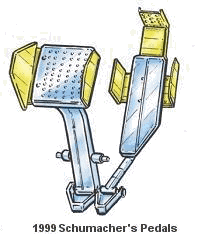 |
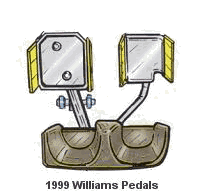 |
Because inside tight F1 cassis there is not enough space for left foot rest pedal (as in the rally car), drivers foots are always on the pedals. That's why there are braces fitted on the sides of each pedal to prevent any movement of the foot during the race.
During nineties, certain Michael Schumacher enters in F1 world. He was the first of Formula 1 drivers to use full potential of left foot braking. During his first and second year in F1, all engineers and drivers of other teams where surprised to hear his car passing trough corners with full throttle applied. He was controlling the speed and brake bias of the car using the only the brakes. His control of the car trough corners was unbelievable.
To have a complete picture of performance driving, take a look at Corners, Setup, Traction circle, Using tires, braking, advanced braking, WRC braking technique, Slipstreaming, drifting, cornering, shifting, Heel and toe driving technique and steering technique articles






